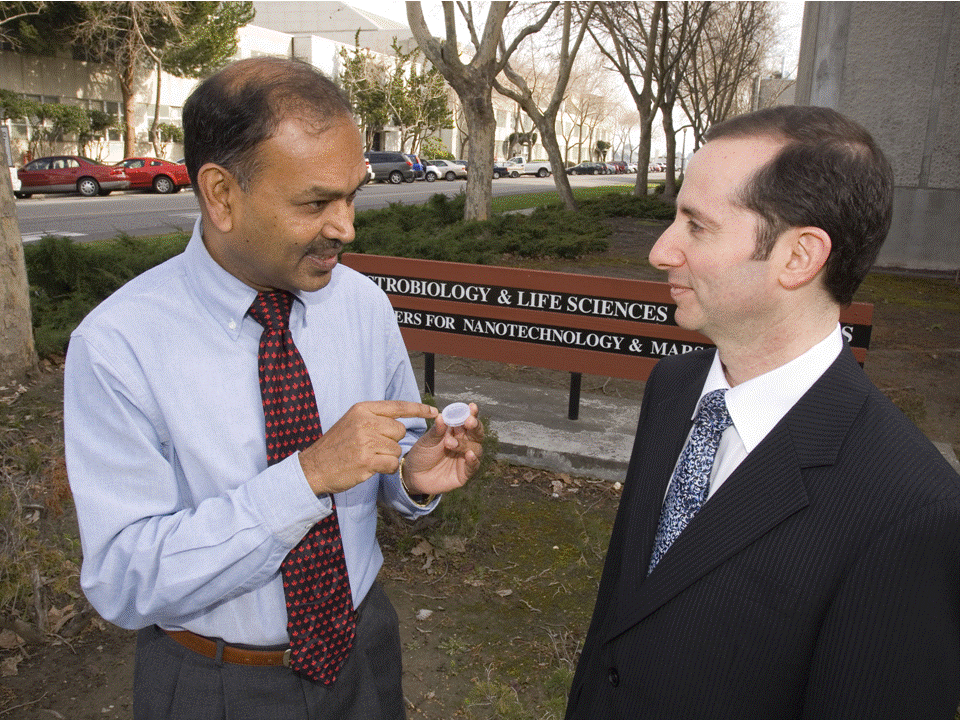Early Warning is a spin-off from NASA’s Ames Research Center in Silicon Valley. In the late 1990’s NASA’s Center for Nanotechnology was the world’s largest nanotechnology center researching carbon nanotubes, the wonder material of nanotechnology. Carbon nanotubes are ideal for space use because of their incredible physical and functional properties – including stronger and lighter than steel, and more conductive than copper. One area of NASA’s experimentation was to determine how carbon nanotubes might be used to detect bacteria during space travel and on space missions such as Mars. Many unique design challenges had to be addressed such as extremely limited physical space and mass, minimal power usage, and minimal reagents and toxic byproducts. This lead to NASA’s biodetection platform that employed carbon nanotubes randomly placed on an electrode to detect bacteria.
Early Warning was formed to exploit the improved capabilities of nanotechnology in biodetection and developed a new generation of new products for rapidly detecting pathogens in industrial, environmental, and subsequently medical applications.
In June 2007, Early Warning obtained an exclusive license to commercializing NASA’s biosensing platform. The Company subsequently produced a more sensitive biosensor along with an on-board concentrator that enables processing of much larger samples than traditional methods and avoids the need for time-consuming polymerase chain reaction (PCR) or other amplification techniques. The Company developed its biosensor internally, with input and participation from engineers at NASA under a 5-year Space Act Agreement for product enhancements. The automated sampling system, concentrator and wireless communications were developed with a $2.3 million grant from Sustainable Development Technology Canada. The Company has engaged leading water organizations in Ontario for validation testing. Over 30 employees and contractors are involved in development and testing activities in Silicon Valley, Canada and specialized US labs.
Early Warning was awarded the Frost & Sullivan 2009 North America Product Innovation Award.
|
Nanotechnology pioneers NASA’s Meyya Meyyappan, chief scientist for exploration technology and former director of the Center for Nanotechnology at Ames Research Center (left) and Early Warning’s President Neil Gordon examine a prototype of NASA’s nanotechnology-based biosensor licensed to Early Warning.
(Source: NASA)
|
|
 |
Pathogens kill 18.4 million people each year and sicken billions. Nearly 100 million Americans comprising 1/3 of the population get pathogen illnesses each year from food and drinking water - 76 million illnesses from foodborne pathogens (Source: CDC) and 19.5 million illnesses from drinking water pathogens (Source: New York Times).
Industry incurs billions of dollars of economic losses from pathogens which cause:
Ø Product recalls (Salmonella, Mad Cow disease, Listeria)
Ø lawsuits (E.coli, Legionella, Flesh-Eating Bacteria),
Ø lost tourism (SARS, West Nile Virus), and
Ø extended hospital stays (MRSA, c. difficile)
Governments are increasingly concerned about pandemics (H1N1 Virus and Black Plague bacteria each of which have killed 50 million people) and bioterrorism. This has caused the UK government to prepare an emergency plan to rapidly process 700,000 dead bodies using mass graves, inflatable mortuaries, 24-hour cremations and express funerals. Illnesses and business losses are expected to rise from:
Ø Increased presence of pathogens in food, water, pharmaceuticals, industrial products, and the environment from a rise of pathogens in source water and ingredients; infiltration of pathogens in processing equipment and deteriorating water distribution infrastructure; an increased use of recycled sewage water replacing depleted pristine source water for drinking, irrigation, fisheries, food production, and industry; and increased imports of food products from Mexico, China, and other under-regulated countries.
Ø Increased number of elderly, immuno-compromised and malnourished as well as illegal aliens whose immune systems are unable to fight off pathogens and will become sick or die from pathogen illnesses. With the passing of Obama-care, healthcare costs from previously uninsured victims will be borne by the government.
Ø Inability to detect pathogens in a timely and cost-effective manner using decades-old laboratory methods and manual sample collection that provide results in 2 to 14 days. Pathogens are typically ingested by consumers before test results are known. Testing is done too infrequently because of the high cost for expensive government certified biosafety laboratories and labor-intensive field sampling. For example, E.P.A. drinking water regulations require daily bacteria testing of only 126 gallons/day out of 43 billion gallons/day supplied by the US Public Water System, which is statistically meaningless at 0.000,000,3%. See “America Needs A New Strategy for Safe Drinking Water” at http://www.nanotech-now.com/columns/?article=441